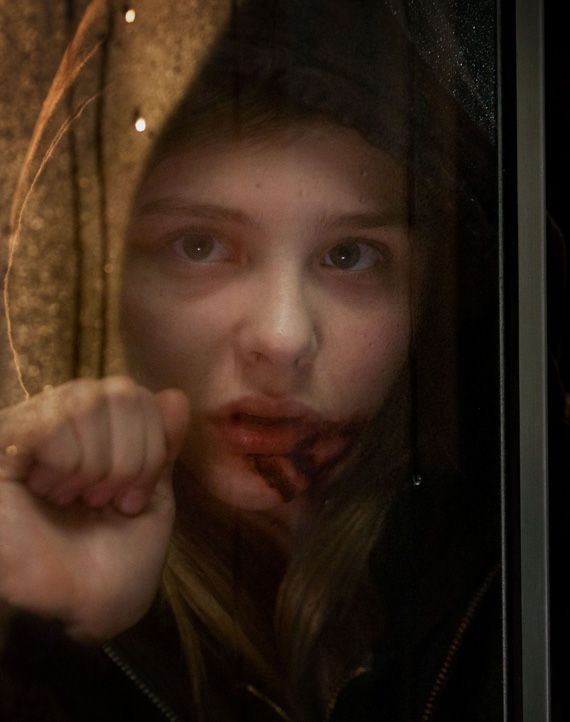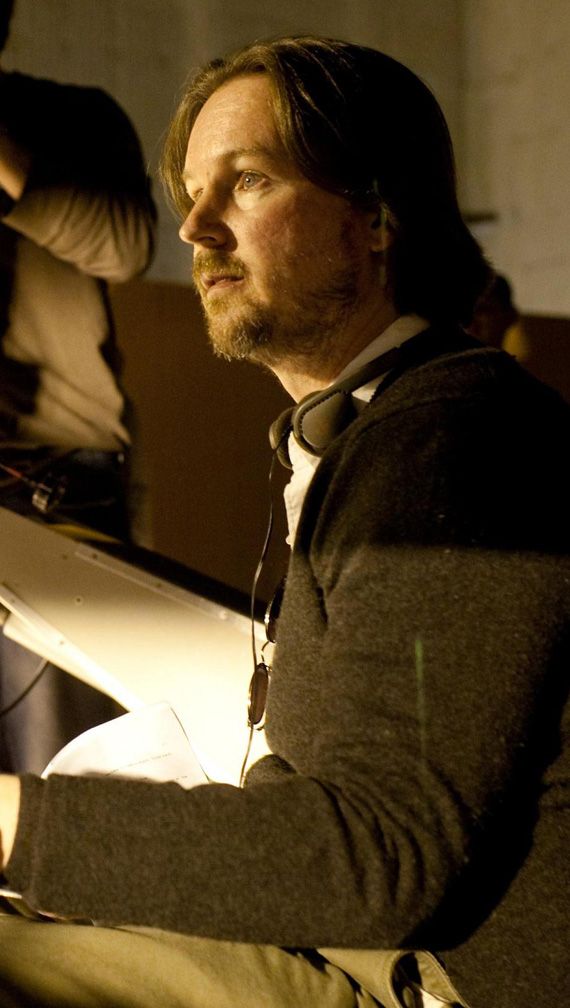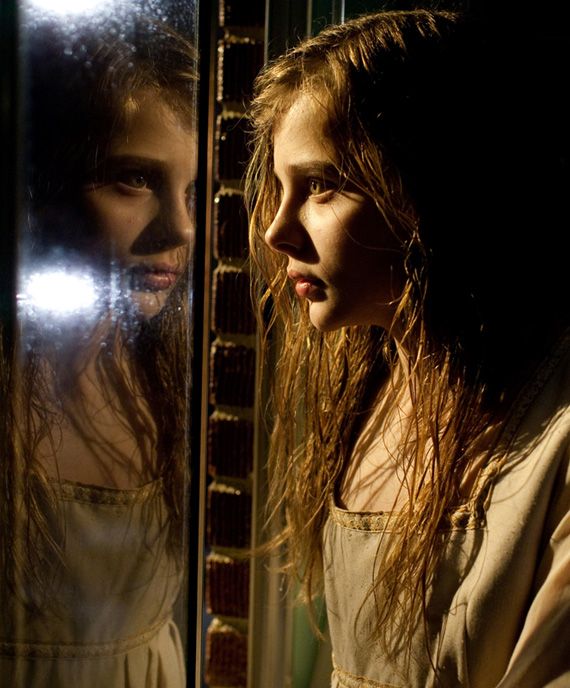As much as it's a story about a blood-thirsty vampire, Let Me In is also a tale of growing up.
Based on the critically acclaimed novel Let the Right One In by Swedish novelist John Ajvide Lindqvist and the Swedish film of the same name, director Matt Reeves' American adaptation depicts two lonely children in an appropriately desolate New Mexico suburb: Owen (Kodi Smit-McPhee) is socially awkward, obsessed with Now & Laters and an easy target for bullies, while Abby (Chloe Moretz) is an ageless entity trapped in a thirteen year old body, moving from town to town with her tired guardian on a seemingly endless quest for blood. When Owen and Abby cross paths, they're forced to confront the realities of who they are; but perhaps these realities aren't insurmountable.
Let Me In arrived in theaters last weekend, and to mark the occasion, Spinoff Online was invited to participate in a round table interview with Reeves and Moretz alongside a small group of journalists. The director and star discussed the challenges of adapting such a beloved story for American audiences, the process of turning Moretz into a menacing vampire and much more, including a brief Kick-Ass 2 update.
The two also did their best Tyrannosaurus Rex impression — yes, really!
Question: Chloe, in making these last two movies [Kick-Ass and Let Me In], what do you feel that they kind of prepare you for?
Chloe Moretz: Everything, really. It's physical, it's mental. Let Me In definitely helped me stretch my emotional boundaries, because I had to show more of my eyes than probably any other film I've done, because it's probably the quietist film I've ever done. There's barely any dialogue between me and Kodi. Most of the time I was just looking at him and I had to express this love, and at the same time this sadness, in my eyes. He definitely helped, because he gave so much to me that I was able to give back.
Matt, talk a little bit about directing her to get those silent moments and making them work.
Matt Reeves: That was the thing that struck me when Chloe first came in. I wanted somebody who was... she was so loud, it's crazy! [Laughs] You can see that she brings an incredible spirit to the set. It was very serious, but then she made everyone laugh.
Moretz: [To Matt] Do the T-Rex!
Reeves: Do the T-Rex? Okay. [Both of them pose as dinosaurs and make the appropriate noises.] This is what she likes!
That's going to be hard to translate in writing!
Reeves: Yeah, people are going to be like, "What was that? I don't understand!" [Laughs] But I didn't want somebody to come in and play a vampire, per se. A lot of the young actresses coming in were doing that. Chloe came in and we discussed it. I was really intrigued the first time she came in. I could just see her thinking. That's so much of what the role is about. Then I said, "Come in again." We looked at these photographs and Chloe became incredibly internal. I didn't know that she could also be incredibly physical — I'd heard about Kick-Ass...
Moretz: It wasn't out by then.
Reeves: It was quite different. [Laughs] But I knew from spending time with her in those auditions that she was incredibly thoughtful and you could see a lot of what she was feeling coming across when she wasn't saying anything. The movie is very much, in terms of their relationship, the moment between the lines of dialogue where the most comes through. It was very clear that Chloe was capable well beyond her years at expressing that.
Can you talk about setting the film where and when you did, and what it was like working in New Mexico?
Reeves: It was great. Our crew was amazing. I'd say we shot about half of the movie in Albuquerque and half of the movie in Los Alamos, which is where it's set. Los Alamos was great. They've done some shooting there, but not a lot, and all of the locations we shot there, no one had ever shot there. I originally wanted to set the movie in Colorado, and frankly, somebody said, "Listen, your budget is tight. We've got great tax incentives in New Mexico." I didn't know a lot about New Mexico and I said, "But wait, it's got to snow." They said, "It's desert but it's high desert." Then I realized it was sort of John Ford Country and I thought that was kind of amazing, the idea of having this very quintessentially American vista that the film opens with. It's funny, because my friend [and colleague] Drew Goddard grew up in Los Alamos and he said, "That's the view from my parent's house. That's the big Los Alamos view!"
I started thinking it would be very interesting to set it in Los Alamos, because I was looking for an American suburb. In the Swedish novel, Lindqvist talks about how the place where he grew up is this kind of plain community and it has no history except the recent history, so there's no church and all of the inhabitants there are therefore unprepared for the evil that's about to be visited upon them. I wanted to find an American version of that, and I was kind of thinking of Spielbergia, like the films he made in the '80s like E.T.. When Los Alamos came up, I thought it was a very unusual suburb that sprung up all at once for a very particular piece of American history. I just thought it was interesting. I did some research and very quickly my friend Drew's name came up, and he'd grown up there. I said, "Well, you know the story [of Let the Right One In]. Would it work here?" And he said, "Yeah, if you make it there, it may as well be my childhood."
And setting it in the '80s?
Reeves: In the novel, Lindqvist set it in the '80s. I really related to the coming of age story, and Lindqvist and I are about the same age. In reading the book, I noticed all of the cultural specificity that came from the idea of growing up at that time in Sweden. In trying to translate [the novel], I wanted to be very faithful to the coming of age story. A lot of that stuff is verbatim out of the book, but I wanted to put it in a context that I remembered from growing up at that time. That's really what that was about.
When you look at the film and you compare it to other films like The Innocents or even The Lady in White, it seems that there's more of a subtextual darkness to those films than I found in Let Me In. In crafting the film and trying to retell the story for an American audience, were you a little bit conscious of that and trying not to be as dark?
Reeves: You know, there wasn't an attempt to do that. I'd say that it has more to do with the tone in Lindqvist's novel. The Innocents, which is a great movie, those kids are very eerie. The thing about this story is that Lindqvist found a way to express some of the pain of growing up through a vampire tale. You're meant to identify with those characters, so in that sense, it's warmer and tender. The darkness is about the juxtaposition of those tones. What really struck me about his tale is the idea that there's real darkness on the one hand, but also real tenderness. That's really unusual.
Obviously, within The Innocents, that's not the case. It's a very eerie, amazing movie, and the kids are, in a way, there's something mysterious about them — and obviously there's something very mysterious about Abby, but it really is meant primarily for you to identify with them and connect to their pain through this story. In that sense, I guess it doesn't distance you from them emotionally, so it doesn't seem as eerie. But hopefully there's a lot of other eerie stuff playing against it that gives you the horror side.
I wanted to bring up Elias Koteas' character. In the original movie and in the book, that particular character seems to be the boyfriend who goes looking for [Abby].
Reeves: It's actually two different things. In the book, there actually is a policeman, and his name is Stefan. Some of the dialogue — that line that he says in the beginning, "We want to know who you are and we'll find out sooner or later; you can save us some legwork by communicating with us now." That's right out of the book. There's another character named Lacke, and he's Virginia's boyfriend. The thing I wanted to do was introduce the policeman character as a sort of fate moving closer and closer to the Romeo & Juliet story, and obviously that's what Lacke ends up doing in the Swedish film and in the novel. Because I wanted to put the story as much as possible into the kids' point of view, I really didn't want to follow Virginia's story except to show how she effects coming of age. So you don't really know her history, but you see Kodi getting glimpses of her life and getting a view into the world of adults.
Once that happened, it made it an imperative not to make it Lacke, because if it was Lacke — or Larry, in our story — you would have to follow their scenes and understand that whole motivation. I wasn't really wanting to tell the story in that way, and I liked the idea of introducing the policeman as someone who was initially the moral eyes of the movie, looking at this horror right in the eye and not understanding it. Over the course of the movie, you would come to understand the sort of surprising source of all of this and actually feel for these characters. It doesn't change the horror of it, but it actually makes you feel for the characters. I felt that if you used him in that way, he could be getting closer and closer to Abby, and you knew that she would be in trouble and it would heighten the Romeo & Juliet side of the story, which I loved.
Chloe, how is it seeing yourself on the screen in these types of movies?
Moretz: I'm very proud. I have to say that Matt is phenomenal, and if I was a horrible actress, he would still find some way to make me look good.
Reeves: And she's not a horrible actress. [Laughs] Tell them what happened — she scared herself! We had our premiere in Los Angeles...
Moretz: I hadn't seen the full finished film. The [rough cut of the] film, the sound wasn't all crazy, and I saw it and thought, "It's not that scary right now. I'm actually not that freaked out by it right now." Then I saw it in LA and I was like, "Ahhh!" I was screaming in the whole place. My mom was like, "Chloe!"
Reeves: When Chloe jumped out of the tub, she literally scared herself. [Laughs] It's funny, when we're shooting the scenes, obviously there's all of the tender stuff that's at the core of the movie. But she's also immediately able to jump into the primal side. We would be sitting there on the ground doing all of this primal stuff, and her mother would be sitting there watching the monitor saying, "I don't know where that's coming from!" It was amazing, and when I showed it to Chloe, she was like, "Ew, gross!" So she gets into it.
When you saw the makeup, was that a revelation?
Moretz: I laughed! When I booked the role, I was thinking it was going to be awesome. "I'm going to have fangs, I'm going to have a white face and stuff — this is going to be awesome!" Then I showed up and Matt's like, "This is what we're thinking — acne all over your face!" And my teeth! I was like, "I'm not going to have fangs? Oh, okay, Matt..." It turned out to be something totally different from what I was expecting, and that's what I love about the movie. It's different from any other vampire movie out there right now, and Matt definitely made that happen.
Can you talk about the process of putting on the makeup?
Moretz: The eyes were crazy. I couldn't see and I couldn't be in there for more than...
Reeves: She couldn't see when she had to run!
Moretz: I had to run down hallways and turn without tripping, so the ground had to be swept clean because I was barefoot. I had to have a clear path. It made me completely blind. Matt would be talking to me and I would be like, "Matt? Matt?" He'd be like, "I'm over here!" I'd be like, "Hello?" But I didn't run into any walls!
Reeves: The idea was that I wanted to do a vampire that was like adolescence gone wrong. She had teeth that weren't fangs, but you know that moment before you have to have braces? Just the idea of all of those things happening when your body is suddenly out of control and all of these changes are happening to you. [Laughs] She was thrilled to know that that was the direction we were going in.
Your movie has a very distinct visual style. How much did you try and stay with the original film and how much did you try and distance yourself from it, or try and outdo it?
Reeves: The way we tried to stay with the original was the story and there were different aspects of the book that I tried to draw in. The scenes that are actually most similar are verbatim out of the book — those scenes in the jungle gym, the dialogue is virtually the same. I really wanted to be faithful to the story I had fallen in love with.
Visually, there was no attempt, no matter what may have happened, to ape that at all. My director of photography had never seen the movie, Chloe hadn't seen the movie, Kodi hadn't seen the movie, Richard Jenkins hadn't seen the movie, and the idea was that we would sort of try and make our own version of the story, kind of a passionate labor of love, and let it grow and be what it is. If we tried to copy anything, I think it would have felt hollow and empty, so there was no attempt to copy anything.
In fact, I had attempted what I thought would be different, which is more of what I look at as kind of my style, a bit more point of view. I love the restraint; the closest thing is that I love the restraint in the tone from the first film, but visually, the movie is more intimate in terms of being closer and more from their point of view. In terms of developing the suspense, more of a classic Hitchcockian mode, if that makes sense.
Chloe, did you get to see Kodi in The Road?
Moretz: I'm not allowed to watch R-rated films, other than my own. My parents are very strict, so I'm not even allowed to see Let The Right One In.
Do you have a list of the ones you'll see when you're allowed?
Moretz: I was allowed to watch Interview with a Vampire and I got to see Kill Bill for Kick-Ass, which was awesome — one of my favorite films ever! That was pretty great. But yeah, I've got Taxi Driver in mind that I want to see. [Laughs] I'm going to go all out. I want to see Leon, The Professional.
Reeves: I see what you're doing here... [Laughs]
Are you looking forward to Kick-Ass 2?
Moretz: Well, it's not announced. Kick-Ass 2 the comic book is on, but it's not announced, the film, from my point of view. Matthew [Vaughn] hasn't talked to us at all about it. Matthew's doing X-Men right now. But honestly, I haven't been told a single word yet, and I'm not lying!
When preparing for a role like this, is it difficult? It's kind of a very adult role to play.
Moretz: My brother Trevor has been my acting coach since I started in this business. Me and Trev, we kind of figured out the role in the beginning, and when I met Matt, we went even more in depth with it, obviously, because he's the director. He showed me pictures of this homeless family. It was a family who lived on the go. He said, "This is kind of how I envision Abby; this old soul in the eyes, but at the same time, she's a thirteen year old girl. She's had a rough life." If you were three hundred years old, would you remember your parents? Would you remember your life? Do you even remember who you were? What's your name? Are you human anymore at all? Do you have any semblance of life in you? It was a lot to try and figure out, but every day it was pretty amazing to get into costume and become this character. I was pretty tired at the end of the day, though. [Laughs] Very, very tired. I'd come home with a stained face from blood, a little orange beard. It was pretty funny.
Director Matt Reeves' Let Me In is currently playing in theaters nationwide.




